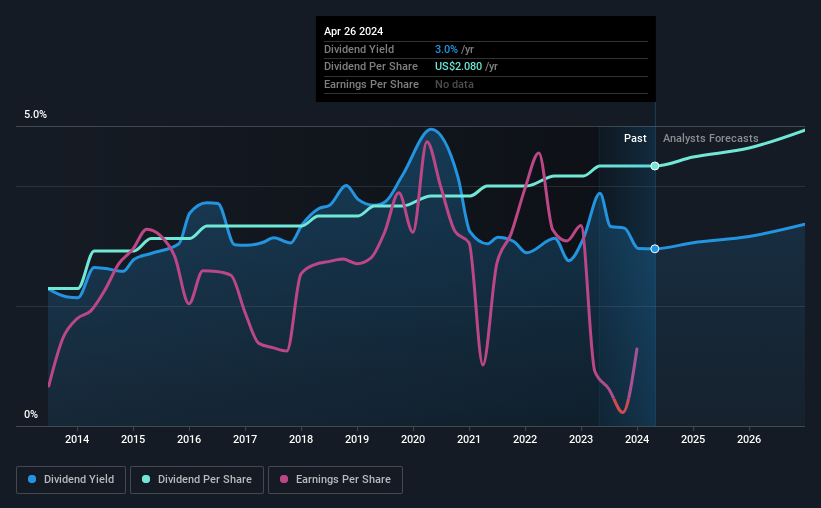The board of MetLife, Inc. (NYSE:MET) has announced that the dividend on 11th of June will be increased to $0.545, which will be 4.8% higher than last year's payment of $0.52 which covered the same period. This takes the dividend yield to 3.0%, which shareholders will be pleased with.
View our latest analysis for MetLife
MetLife's Earnings Easily Cover The Distributions
Impressive dividend yields are good, but this doesn't matter much if the payments can't be sustained. Prior to this announcement, the company was paying out 113% of what it was earning, however the dividend was quite comfortably covered by free cash flows at a cash payout ratio of only 11%. Given that the dividend is a cash outflow, we think that cash is more important than accounting measures of profit when assessing the dividend, so this is a mitigating factor.
According to analysts, EPS should be several times higher next year. Assuming the dividend continues along recent trends, we estimate that the payout ratio could reach 21%, which is in a comfortable range for us.

MetLife Has A Solid Track Record
The company has been paying a dividend for a long time, and it has been quite stable which gives us confidence in the future dividend potential. The annual payment during the last 10 years was $1.10 in 2014, and the most recent fiscal year payment was $2.08. This works out to be a compound annual growth rate (CAGR) of approximately 6.6% a year over that time. Companies like this can be very valuable over the long term, if the decent rate of growth can be maintained.
The Dividend Has Limited Growth Potential
Some investors will be chomping at the bit to buy some of the company's stock based on its dividend history. Let's not jump to conclusions as things might not be as good as they appear on the surface. MetLife's earnings per share has shrunk at 17% a year over the past five years. Dividend payments are likely to come under some pressure unless EPS can pull out of the nosedive it is in. However, the next year is actually looking up, with earnings set to rise. We would just wait until it becomes a pattern before getting too excited.
Our Thoughts On MetLife's Dividend
In summary, while it's always good to see the dividend being raised, we don't think MetLife's payments are rock solid. The company has been bring in plenty of cash to cover the dividend, but we don't necessarily think that makes it a great dividend stock. We don't think MetLife is a great stock to add to your portfolio if income is your focus.
Companies possessing a stable dividend policy will likely enjoy greater investor interest than those suffering from a more inconsistent approach. Still, investors need to consider a host of other factors, apart from dividend payments, when analysing a company. Taking the debate a bit further, we've identified 4 warning signs for MetLife that investors need to be conscious of moving forward. Looking for more high-yielding dividend ideas? Try our collection of strong dividend payers.
New: Manage All Your Stock Portfolios in One Place
We've created the ultimate portfolio companion for stock investors, and it's free.
• Connect an unlimited number of Portfolios and see your total in one currency
• Be alerted to new Warning Signs or Risks via email or mobile
• Track the Fair Value of your stocks
Have feedback on this article? Concerned about the content? Get in touch with us directly. Alternatively, email editorial-team (at) simplywallst.com.
This article by Simply Wall St is general in nature. We provide commentary based on historical data and analyst forecasts only using an unbiased methodology and our articles are not intended to be financial advice. It does not constitute a recommendation to buy or sell any stock, and does not take account of your objectives, or your financial situation. We aim to bring you long-term focused analysis driven by fundamental data. Note that our analysis may not factor in the latest price-sensitive company announcements or qualitative material. Simply Wall St has no position in any stocks mentioned.
About NYSE:MET
MetLife
A financial services company, provides insurance, annuities, employee benefits, and asset management services worldwide.
Established dividend payer and good value.
Similar Companies
Market Insights
Community Narratives



